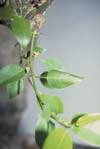Home >
Ficus citrifolia, Shortleaf Fig
Shortleaf Fig is an attractive, tall, upright tree with whitish-gray bark. It attains a height of 40 to 50 feet and has a broad crown. This Fig has few aerial roots; the roots seldom become prop roots or stranglers. The Shortleaf Fig is considered to be semi-deciduous in that there are up to three flowering and fruiting seasons a year (winter, spring, and fall), and many leaves are shed before the flushes of new growth begin. The glossy leaves are dark green above with pale green undersides. The flowers of this tree are minute and are found inside the edible fruit. The fruits are round, maroon when ripe, sweet to the taste, and 1/2 to 1 inch broad. They are attractive to birds and are especially appealing to the Cedar Waxwing during its migrations through south Florida.
This native Fig can be used as a specimen or shade tree in parks, school grounds, and roadsides. Its large size makes it ill suited for many home landscapes. Trees drip white latex sap which can be difficult to remove from automobiles. Thin the tree regularly, especially toward the outer edge of the canopy, to minimize damage from storms. Alkaline soils suit this tree just fine, and trees are drought tolerant once established.
The Shortleaf Fig demands little attention and creates a perfect environment for ferns, palms and aeroids. This tree requires less maintenance to control aggressive aerial and surface roots than the other members of this genus. Because the flowers are found inside the fruit, the process of pollination is quite interesting. Pollination occurs when a female wasp maneuvers her way into a developing fruit to lay her eggs; she fertilizes the female flowers inside the fruit with pollen collected in her pollen sacs. Pollen causes little or no allergies.
Plants serve as larvae hosts for ruddy dagger wing (Marpesia petreus) butterflies.



